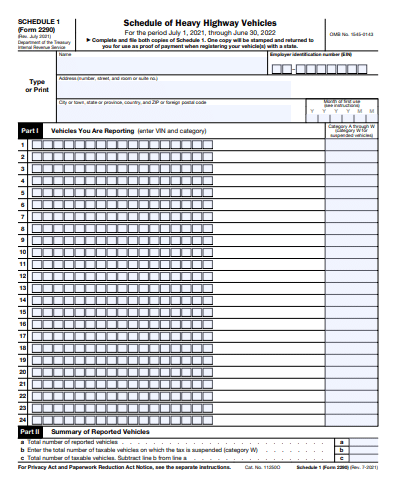
Understand the significance of a vehicle identification number in HVUT e-Files and learn how to eFile Form 2290 VIN Correction accurately with 5 quick tips.
Businesses within the trucking industry understand the importance of Form 2290 VIN Corrections. If you’re not familiar with the term or if you’re new to HVUT taxes, understanding Form 2290 is really essential.
To help you understand what a VIN Correction is, let me give you a quick background on a vehicle identification number, otherwise known as “VIN”.
Defining Vehicle Identification Number (VIN)
A vehicle identification number is assigned to every vehicle to identify it with a unique code. A vehicle identification code cannot be random. It has to follow a standardized sequence to denote the geographical origin area, the manufacturer’s details, and other vital vehicle information.
Role Of A VIN In HVUT Taxes
A vehicle identification number helps the IRS tax the current owner of the vehicle. Even if a vehicle has multiple owners, they all are severally required by law to file and pay their taxes with an exception to a few cases.
For Form 2290, which essentially deals with Heavy Vehicle Usage Tax, any vehicle that weighs 55,000 pounds or more is taxed by the IRS according to its gross taxable weight and mileage utility.
Now, owner-operators, truckers, fleet owners, trucking companies, and businesses within the trucking industry tend to operate with heavy vehicles that fall within the HVUT laws.
So, they are required by law to file their 2290 forms and pay the HVUT tax every year. If you’re a fleet owner or a trucker, you too are required to report the vehicle identification number, vehicle weight, mileage utility, and other information in Form 2290 and submit it to the IRS.
What Is A 2290 VIN Correction?
A 2290 VIN Correction is a form, which must be filed by the vehicle owner or their assigned designee if the previously filed 2290 return has been rejected for reporting an incorrect VIN. A 2290 return can also be rejected if you miss reporting a VIN in Form 2290.
How Would The IRS Know That I Reported An Incorrect VIN?
You see, a 2290 return, once submitted, will be meticulously reviewed by several checkpoints at the IRS office. The IRS has a record of all the vehicle identification numbers and their respective owners.
As soon as they receive your 2290 return, the IRS immediately scans the database to look for the VIN/Name combination you have entered in the form.
It is essential to ensure that you report the vehicle identification number and the vehicle owner’s name accurately. This is one of the most crucial defining factors of HVUT taxes.
Why Would The IRS Reject A 2290 Return For An Incorrect VIN?
Example scenario: Let’s assume that you have reported an incorrect VIN and you’ve submitted it to the IRS. Let’s also assume that the IRS did accept your incorrect VIN (they never miss an incorrect VIN FYI, but this is a hypothetical scenario. So, stay with me on this).
And let’s assume that the VIN you have entered does not exist in the IRS database, then the IRS will conduct a thorough background check to confirm if the vehicle exists.
Upon research, if the IRS concludes that the VIN doesn’t belong to you; your return will be rejected.
Now, let’s assume that the IRS accepts an incorrect VIN that you’ve reported. Let’s also assume that the reported VIN belongs to another taxpayer. You’re practically paying someone else’s taxes (when you should be paying yours).
And let’s assume that this taxpayer happens to have a notorious non-compliance history, lo and behold, you have just scored the attention of the IRS and heavy penalties + serious consequences (think imprisonment).
By trying to fabricate someone else’s VIN as yours; you have committed identity theft. And these unlawful practices are not tolerated by the IRS.
So, for your own peace of mind, follow the simple and lawful procedures laid out by the IRS, and correct an incorrect VIN by filing Form 2290 VIN Correction.
Note: It is important to understand that the IRS is more focused on filers reporting the information accurately than on assessing penalties. Having said that, if the IRS does find inaccurate reports or false positives, be prepared to receive notices and be on their non-compliant taxpayer’s list.
When Do You File A 2290 VIN Correction?
When the IRS rejects your 2290 return citing an incorrect VIN or missing VIN, then you are required to file a 2290 VIN Correction for the previously filed form 2290 return. If you happen to realize that you have reported an incorrect VIN after you have received Schedule-1, you still have the scope to file a 2290 VIN Correction.
By filing a VIN Correction, you are communicating to the IRS that there may have been a mistake in the previous reports.
Do note that you’re filing VIN Correction for vehicles that are already listed in your Schedule-1. New vehicles (that are not listed in Schedule-1) must be reported with a new Form 2290.
The following section will help you understand the right way to eFile Form 2290 VIN Correction and gives you some tips to prevent file rejections.
5 Quick Tips To E-File Form 2290 VIN Correction Accurately
e-File Form 2290 VIN Correction – 5 Quick Tips To Boost Accuracy.
Tip 1: Select ‘VIN Correction’
As seen in the image below, mark the VIN Correction box to clarify that you are filing a 2290 VIN Correction. If you do not select this box, the IRS will treat this as a new file, which leads to duplicate reports.
Tip 2: Validate Your VINs
Before you enter the corrected VIN in the form, be sure to quickly run the VIN through any authorized VIN Check tool. This will help you validate the VIN and report the correct information in the form. It will also help you decide if you need to file a VIN Correction or a 2290 Amendment.
- Free VIN Check tools that help decode and validate your VINs
Tip 3: Enter The Correct VIN
As you can see from the Form 2290 excerpt below, you have to enter the correct vehicle identification number in the “VIN You Are Reporting” column and enter the category of the vehicle in the column on the right. Do not enter the VINs for vehicles that have already been reported correctly in Schedule-1.

Tip 4: Enter The Correct EIN
There must be no disparities in the EIN reported in your previous return and the 2290 VIN Correction. If you are a tax professional filing a VIN Correction on your client’s behalf, be sure to validate the EIN before you enter it in the VIN Correction form. Do note that you and your client will be held accountable if there are disparities in the EIN reported in a 2290 VIN Correction form.
Tip 5: Correct All Incorrect VINs At Once
Before you submit your correct VINs, be sure to review your Schedule-1 and run all the VINs through a VIN Check tool to verify if the VINs are valid and report appropriately. If you see that one or more VINs need to be corrected, report all VIN corrections in a single Form 2290 VIN Correction and submit the form to the IRS. Avoid duplicate filings and reports.
e-File Form 2290 VIN Correction With EZ2290
EZ2290 is an IRS-authorized e-File provider, enabling businesses with convenient HVUT e-Files and tax compliance.
Apart from helping truckers and businesses with 2290 e-Files, we also provide tax compliance support to help you re-File your rejected returns at no additional cost.
You can securely e-File a 2290 VIN Correction in 4 simple steps with EZ2290.
Step 1: Create your free account. No credit cards are required. No hidden fees.
Step 2: On your EZ2290 dashboard, select the filing period for which you’re filing a VIN Correction
Step 3: Validate the information prior to reporting
Step 4: Securely submit Form 2290 VIN Correction to the IRS
You will be able to view a confirmation message once the e-file has been successfully submitted to the IRS.
Start Your HVUT Compliance Journey Today With EZ2290
eFile IRS Form 2290 with EZ2290 in 3 easy steps.
Related Ez2290 Blogs:
- What Is Form 2290? Are You Required To File It?
- IRS Form 2290 Instructions For The 2021-2022 Tax Year
- Vehicle Identification Number (VIN) – Here’s Everything You Need To Know
- IRS Form 2290 Due Date For The 2021-2022 Tax Year
- Everything You Need To Know About IRS Form 2290 Amendment
- Complete HVUT Compliance For Your Trucking Business With EZ2290
- Your Ultimate Guide To Understanding IRS HVUT Form 2290






